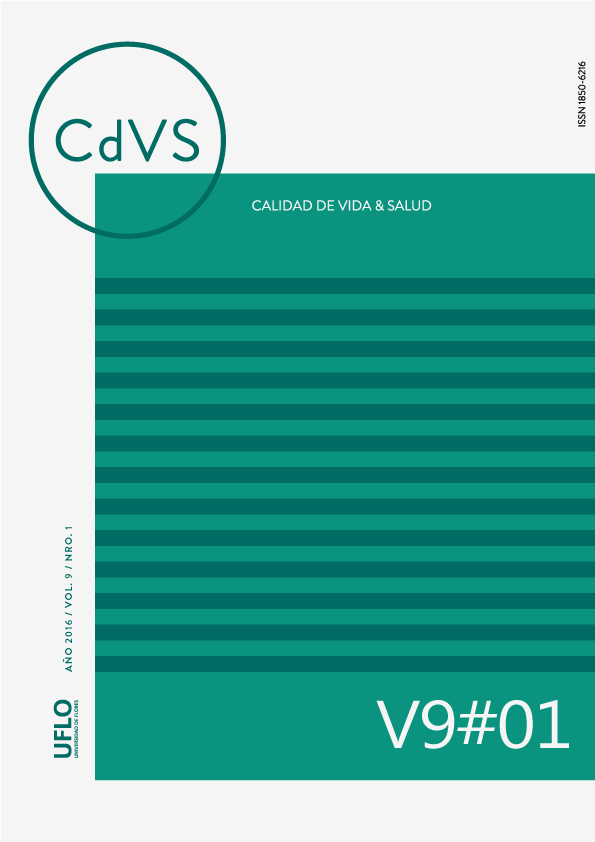La influencia del bullying en la autoestima de los adolescentes
Keywords:
autoestima, bullying, adolescencia.Abstract
Peer harassment o bullying is an extremely difficult situation to be lived by victims and bystanders. It’s know that there are serious negative consequences like low self-esteem, anxiety or stress that will follow in the adulthood. That’s why is interesting to know in detail how to be a bully affect his self-esteem. This study aims to analyze the impact that can have any of the three roles involved in situation of bullying (victim, bully or observer) on the self-esteem of an adolescent sample. First, we provide data on levels of self-esteem and the three dimensions of the bullying of the adolescents. Then we analyze the effect of each dimension of bullying on self-esteem. The results suggest that only the victim dimension of bullying seems to have a negative relationship with self-esteem.
References
Arce, R., & Fariña, F. (2011). Evaluación forense del acoso moral en el trabajo (mobbing) mediante el sistema de evaluación global. M.Matos, R.Abrunhosa, y C.Machado (Coords.), Manual De Psicologia Forense: Contextos, Práticas e Desafios, , 375-398.
Avilés, J. M., Irurtia, M. J., García-Lopez, L. J., & Caballo, V. E. (2011). El maltrato entre iguales: 'bullying.'. Behavioral Psychology / Psicología Conductual: Revista Internacional Clínica y De La Salud, 19(1), 57-90. Retrieved from http://search.proquest.com/docview/901193606?accountid=14777
Birkeland, M. S., Melkevik, O., Holsen, I., & Wold, B. (2012). Trajectories of global self-esteem development during adolescence. Journal of Adolescence, 35(1), 43-54.
Caballo, V. E., Calderero, M., Arias, B., Salazar, I. C., & Irurtia, M. J. (2012). Desarrollo y validación de una nueva medida de autoinforme para evaluar el acoso escolar (bullying). Psicologí¬a Conductual, 20(3), 625-647. Retrieved from http://search.proquest.com/docview/1268707039?accountid=14777
Campbell, W. K., Baumeister, R. F., Dhavale, D., & Tice, D. M. (2003). Responding to major threats to self-esteem: A preliminary, narrative study of ego-shock. Journal of Social and Clinical Psychology, 22(1), 79-96. Retrieved from http://search.proquest.com/docview/224849551?accountid=14777
Cava, M. J., Murgui, S., & Musitu, G. (2008). Diferencias en factores de protección del consumo de sustancias en la adolescencia temprana y media. Psicothema, 20(3), 389-395.
Cerezo, F., & Ato, M. (2005). Bullying in spanish and english pupils: A sociometric perspective using the BULL‐S questionnaire. Educational Psychology, 25(4), 353-367.
Cerezo, F., & Méndez, I. (2012). Conductas de riesgo social y de salud en adolescentes. propuesta de intervencion contextualizada para un caso de bullying. Anales De Psicologí¬a, 28(3), 705-n/a. doi:http://dx.doi.org/10.6018/analesps.28.3.156001
Coopersmith, S. (1967). The antecedents of self-esteem. San Francisco: WH freeman.
Cuevas Jaramillo, M. C., & Marmolejo Medina, M. A. (2014). Bystanders in situations of bullying victimization. Psicologí¬a Desde El Caribe, 31(1), n/a. Retrieved from http://search.proquest.com/docview/1521671966?accountid=14777
Defensor del Pueblo, U. (2007). Violencia escolar: El maltrato entre iguales en la ESO, 1999-2006. nuevo estudio y actualización del informe 2000.
Dogruer, N., & Yaratan, H. (2014). Developing a bullying scale for use with university students. Social Behavior and Personality, 42, 81-92. Retrieved from http://search.proquest.com/docview/1523923380?accountid=14777
Dorard, G., Bungener, C., & Berthoz, S. (2013). Estime de soi, soutien social perçu, stratégies de coping, et usage de produits psychoactifs l'adolescence. Psychologie Française, 58(2), 107-121. doi:http://dx.doi.org/10.1016/j.psfr.2013.01.003
Elliott, G. R., & Feldman, S. S. (1990). Capturing the adolescent experience. At the Threshold: The Developing Adolescent, , 1-13.
Garaigordobil, M. (2013a). Cyberbullying. screening de acoso entre iguales. TEA, Madrid,
Garaigordobil, M., & Aliri, J. (2013b). Ciberacoso ("cyberbullying") en el país vasco: Diferencias de sexo en víctimas, agresores y observadores. Psicologí¬a Conductual, 21(3), 461-474. Retrieved from http://search.proquest.com/docview/1476261032?accountid=14777
Greenwald, A. G., Bellezza, F. S., & Banaji, M. R. (1988). Is self-esteem a central ingredient of the self-concept? Personality and Social Psychology Bulletin, 14(1), 34-45.
Guillon, M., & Crocq, M. (2004). Estime de soi à l'adolescence: Revue de la littérature. Neuropsychiatrie De l'Enfance Et De l'Adolescence, 52(1), 30-36. doi:http://dx.doi.org/10.1016/S0222-9617(03)00179-X
Haber, J. (2007). Bullyproof your child for life: Protect your child from teasing, taunting, and bullying for good Penguin.
Harknett, K. (2006). The relationship between private safety nets and economic outcomes among single mothers. Journal of Marriage and Family, 68(1), 172-191.
Harter, S. (1990). Causes, correlates, and the functional role of global self-worth: A life-span perspective. in R.J. sternberg &J. kolligian (eds.), competence considered., 67-97.
Harter, S. (1999). The construction of the self: A developmental perspective. New York, NY, US: Guilford Press, New York, NY. Retrieved from http://search.proquest.com/docview/619396561?accountid=14777
Heikkilä, H., Väänänen, J., Helminen, M., Fröjd, S., Marttunen, M., & Kaltiala-heino, R. (2013). Involvement in bullying and suicidal ideation in middle adolescence: A 2-year follow-up study. European Child & Adolescent Psychiatry, 22(2), 95-102. doi:http://dx.doi.org/10.1007/s00787-012-0327-0
Hintsanen, M., Alatupa, S., Pullmann, H., Hirstiö‐Snellman, P., & Keltikangas-Järvinen, L. (2010). Associations of self‐esteem and temperament traits to self‐ and teacher‐reported social status among classmates. Scandinavian Journal of Psychology, 51(6), 488-494. doi:http://dx.doi.org/10.1111/j.1467-9450.2010.00820.x
Hombrados-Mendieta, I. (2013). Apoyo social, clima social y percepcion de conflictos en un contexto educativo intercultural. Anales De Psicologìa, 29(1), 108-n/a. doi:http://dx.doi.org/10.6018/analesps.29.1.123311
Kort-Butler, L. A., & Hagewen, K. J. (2011). School-based extracurricular activity involvement and adolescent self-esteem: A growth-curve analysis. Journal of Youth and Adolescence, 40(5), 568-581. doi:http://dx.doi.org/10.1007/s10964-010-9551-4
Leary, M. R., & Baumeister, R. F. (2000). The nature and function of self-esteem: Sociometer theory. Advances in experimental social psychology, vol. 32 (pp. 1-62). San Diego, CA, US: Academic Press, San Diego, CA. Retrieved from http://search.proquest.com/docview/619581586?accountid=14777
Leary, M. R., & MacDonald, G. (2003). Individual differences in self-esteem: A review and theoretical integration. Handbook of Self and Identity, , 404-405.
Marsh, H. W., Craven, R. G., & Debus, R. (1991). Self-concepts of young children 5 to 8 years of age: Measurement and multidimensional structure. Journal of Educational Psychology, 83(3), 377-392.
Martínez González, M. T. (1999). About self-esteem. what it is and how it is expressed.
Maslow, A. H., Frager, R., Fadiman, J., McReynolds, C., & Cox, R. (1970). Motivation and personality Harper & Row New York.
Musitu, G., & Cava, M. J. (2003). El rol del apoyo social en el ajuste de los adolescentes. Intervención Psicosocial, 12(2), 179-192.
Olweus, D. (1993). Bullying at school. what we know and whal we can do.
Pastor, Y., Balaguer, I., & García-Merita, M. L. (2003). El autoconcepto y la autoestima en la adolescencia media: Análisis diferencial por curso y género. Revista De Psicología Social, 18(2), 141-159.
Postigo, S., González, R., & Montoya, I. (2013). Propuestas teóricas en la investigacion sobre acoso escolar: Una revision. Anales De Psicología, 29(2), 413-n/a. doi:http://dx.doi.org/10.6018/analesps.29.2.148251
Rigby, K. (2008). Children and bullying: How parents and educators can reduce bullying at school. Blackwell Publishing.
Rosenberg, M. (1965). Society and the adolescent self-image. Princeton University Press Princeton, NJ,
Van Houtte, M., Demanet, J., & Stevens, P. A. (2012). Self-esteem of academic and vocational students: Does within-school tracking sharpen the difference? Acta Sociologica, 55(1), 73-89.
Wigfield, A., & Eccles, J. S. (1994). Children's competence beliefs, achievement values, and general self-esteem change across elementary and middle school. The Journal of Early Adolescence, 14(2), 107-138.
Wilson, M. (1995). Best practices in systems influences on children's self-concept. Best Practices in School Psychology, III, , 359-368.
Published
How to Cite
Issue
Section
The authors who publish in this journal accept the following conditions:
1. The authors retain the copyright and assign to the journal the right to first publication, with the work registered under the Creative Commons Attribution license, which allows third parties to use what has been published as long as they mention the authorship of the work and the first publication in this journal.
2. Authors may make other independent and additional contractual agreements for non-exclusive distribution of the version of the article published in this journal (e.g., inclusion in an institutional repository or publication in a book) provided that they clearly indicate that the work was first published in this journal.
3. Authors are permitted and encouraged to publish their work on the Internet (e.g., on institutional or personal pages) before and during the review and publication process, as this may lead to productive exchanges and greater and faster dissemination of published work (see The Effect of Open Access).









